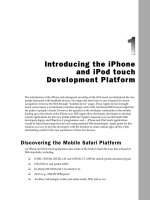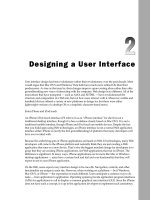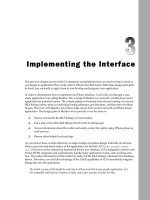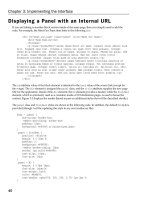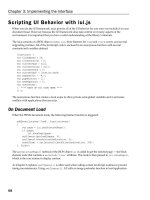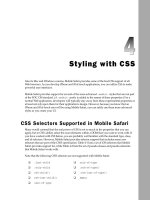Lập trình iphone
Bạn đang xem bản rút gọn của tài liệu. Xem và tải ngay bản đầy đủ của tài liệu tại đây (362.56 KB, 8 trang )
Collection By traibingo
1
Bài 1: Giới thiệu các công cụ để lập
trình iPhone
Theo kinh nghiệm của tôi thì những người đã quá quen với hệ điều hành
windows và làm việc trên nền windows thì rất khó để mà thay đổi thói quen
sử dụng một hệ điều hành khác. Tuy nhiên, cũng theo kinh nghiệm của tôi
thì chỉ cần bỏ một thời gian ngắn chịu khó làm quen với cái mới thì ắt hẳn
sẽ thấy được nhiều điều thú vị mà bên windows không có. Lấy một ví dụ
điển hình như khi bạn chuyển từ windows sang MAC OS bạn sẽ thấy MAC
chẳng có gì hay ho cả, khó dùng, giao diện thì ko được bóng bẩy như
windows 7, khi cần ứng dụng cho MAC thì tìm lè lưỡi cũng chẳng ra, mà có
ra thì cũng khó tìm được bản crack.
Tất nhiên là cũng phải tuỳ vào tính chất công việc mà người ta nên chọn
hệ điều hành nào cho phù hợp. Ở đây, công việc của chúng ta là lập trình
ứng dụng trên iPhone nên MAC OS là một trong số các yếu tố mà bạn phải
có. Ngoài ra, để lập trình được ứng dụng iPhone bạn cần có 1 bộ iPhone
SDK do Apple cung cấp, phiên bản mới nhất hiện nay là 3.1.2 và một bộ
XCode cùng phiên bản dùng để coding và kéo thả giao diện.
iPhone SDK và XCode thì có thể dễ dàng download tại trang web của
Apple còn MAC OS thì tốt nhất là mua đĩa dành cho PC. Việc cài đặt MAC
OS trên PC thực sự không phải dễ dàng chút nào vì theo như kinh nghiệm
cài MAC của tôi thì mỗi máy PC có một dòng MAC OS riêng được hack để
có thể làm việc được trên nền phần cứng tương ứng. Do đó mà khi bạn
chọn mua đĩa MAC nên chú ý đến cấu hình phần cứng của máy. Chẳng
hạn như card âm thanh là do realtek sản xuất hay hãng khác, card đồ hoạ
VGA hay Nvidia, card mạng,... Chỉ cần bạn chọn cấu hình phần cứng lệch
một chút trong quá trình cài đặt thì coi như công cốc.
Ngôn ngữ để lập trình ứng dụng trên iPhone là Objective-C. Đây là một
ngôn ngữ lập trình hướng đối tượng. Tác giả đã phát triển kế thừa trình
biên dịch C và tạo nên trình biên dịch mới cho Objective-C. Vì vậy mà trình
biên dịch Objective-C có thể biên dịch được cả ngôn ngữ C/C++. Trong lập
trình iPhone bạn có thể viết cả 3 ngôn ngữ đó trong cùng một application.
Collection By traibingo
2
Về XCode thì phải nói là quá tuyệt vời khi lập trình trên iPhone do nó hỗ trợ
rất mạnh cho iPhone. Bạn sẽ ko cần phải quan tâm về các đối tượng UI
nữa. Vì Xcode quản lý các đối tượng UI rất chặt chẽ. Chẳng hạn như thay
vì bạn khai báo đối tượng UIButton thì bạn chỉ việc kéo đối tượng button
vào View và ánh xạ nó tới biến UIButton trong mã nguồn nó sẽ tự động
khởi tạo khi load lên...
Có lẽ chỉ một vài lời cũng khó mà diễn tả hết được cái hay của XCode.
Thay vào đó bạn chỉ có thể trải nghiệm và cảm nhận.
Bài tiếp theo chúng ta sẽ học về các đối tượng UI trong lập trình ứng dụng
trên iPhone và cấu trúc của chúng.
Collection By traibingo
3
Bài 2: UITableView Hello world
Trong bài này sẽ hướng dẫn cho các bạn cách tạo một ứng dụng "Hello
world" sử dụng UITableView.
Mục tiêu của bài học:
- Create a New Navigation-Based Application
- Learn About the Default Files
- Update the UITableView Cells to Display “Hello World” Text
Creating a New Navigation-Based Application
Start a new iPhone OS Project
Click Xcode > New Project and a window should pop up like this:
Make sure Application is selected under iPhone OS and then select
Navigation-Based Application. Click Choose… It will ask you to name
your project. Type in “Hello World” and let‟s get started.
Learn About the Default Files
Collection By traibingo
4
What is all this stuff?
There are quite a few files that get added to your project. At first glance,
this looks kind of intimidating. Don‟t worry, we only need to edit one of
them. Here is a quick explanation of the different files. You don‟t have to
read this part but having this many files is what confused me the most
when I started developing for the iPhone.
1. CoreGraphics.framework,Foundation.framwork, UIKit.framework –
You guessed it, this is a set of library functions provided by Apple that we
use in our application. We use these as includes similar to any other
language that includes library functions.
2. HelloWorld.app – This is your app that gets installed on the iPhone. We
don‟t really need to worry about this right now
3. Hello_World_Prefix.pch – This is another include file that gets compiled
separately from your other files so you don‟t need to include it on each file.
It contains some code to include the data inside the frameworks.
4. Hello_WorldAppDelegate.h – This is a header file that contains all of our
definitions for variables that we will be using. It‟s very similar to a header
file in C or C++;
5. Hello_WorldAppDelegate.m – All of the magic starts here. Consider this
file our starting point for execution. The main.m file invokes this object.
6. Info.plist – This contains various meta information about your program.
You won‟t really need to edit this until you are ready to start testing on the
iPhone
7. main.m – Like most programming language, this file contains our main
function. This is where execution begins. The main function basically
instantiates our object and starts the program. You shouldn‟t need to edit
this file.
8. MainWindow.xib – This contains the visual information of our main
window. If you double click on it, it will open in a program called “Interface
Builder”. We will get to this a little later. Just on thing to note is this file does
not contain any code.
9. RootViewController.h, RootViewController.m - These are files for a view
controller that gets added to our main window. Basically, Apple has already
created a simple interface when you clicked on Navigation-Based
Application. Since most navigation-based applications use a Table View,
Apple has provided it for us to use.
10. RootViewController.xib – This is a view that Apple has provided
that emulates a table. It has rows and columns. We will be displaying our
“Hello World” text inside one of these rows
Collection By traibingo
5
Now, all of these files together create a basic program. Go ahead and click
on the Build and Go button at the top of Xcode. Make sure the drop-down
on the top left says Simulator | Debug, this tells Xcode that we are testing
on the iPhone simulator.
You will see the iPhone simulator start and your program will launch. It‟s
not very interesting at the moment. All it shows is the Table View that Apple
has added for us. So what we are going to do is add a row to this table
view.
Update the UITableView Cells to Display “Hello World” Text
Let’s write some code



